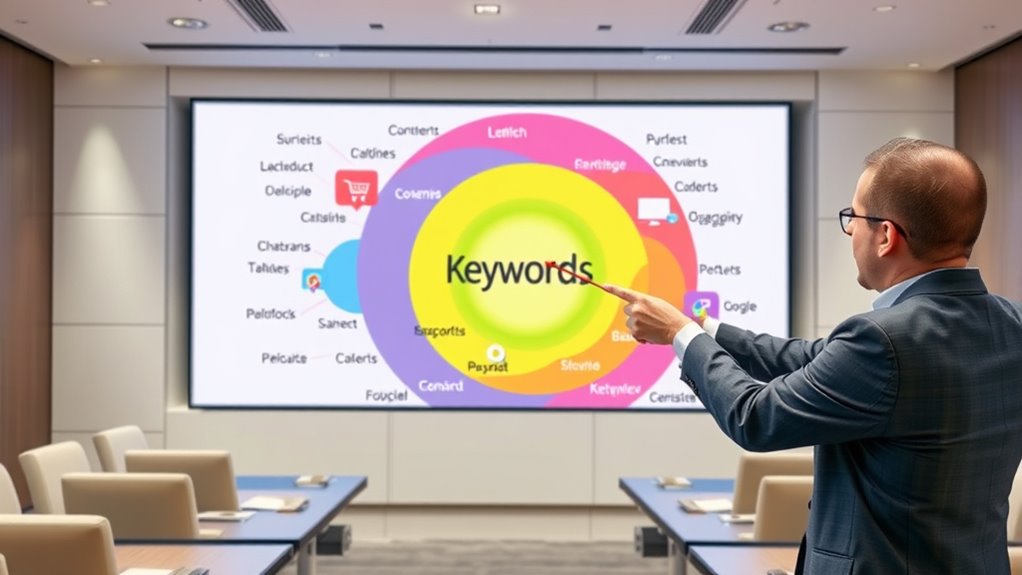To master advanced keyword clustering by intent, you need to analyze search queries to identify user goals like informational, navigational, or transactional. Use tools and algorithms to group keywords based on semantic relationships and intent signals. This helps you craft content that directly matches what users seek, boosting engagement and rankings. If you want to learn how to effectively implement these strategies and optimize your content approach, there’s much more to explore ahead.
Key Takeaways
- Group keywords based on user intent (informational, navigational, transactional) to tailor content effectively.
- Use semantic analysis and clustering algorithms to capture nuanced meanings and improve grouping accuracy.
- Analyze context and search modifiers to resolve keyword ambiguity and enhance intent classification.
- Align content strategies with intent groups to increase relevance, engagement, and search rankings.
- Continuously update clusters with evolving search trends and performance data for optimal content guidance.
Understanding User Intent and Its Importance in SEO

Have you ever wondered why some search results feel more relevant than others? That’s where understanding user intent becomes vital. Keyword personalization plays a significant role here, tailoring results based on your search history and preferences. With semantic search, search engines grasp the meaning behind your query, not just the keywords used. This advancement allows them to deliver more precise responses aligned with your needs. Recognizing user intent helps you optimize your content effectively, ensuring it matches what visitors seek. Whether they’re looking for information, a specific product, or to make a purchase, understanding these motives guides your SEO strategies. Mastering user intent means your content can connect better with your audience, increasing engagement and boosting your chances of ranking higher in search results. Additionally, understanding user intent can help you identify effective budgeting tips and strategies to create content that directly addresses your audience’s financial goals. Being aware of the different types of search intent allows content creators to tailor their messaging more accurately to meet user expectations. Recognizing educational content needs can further refine your approach, especially in fields like AI in Education where personalized and data-driven information is crucial. Knowing how to align your content with specific user needs ensures a more targeted and effective content strategy. Moreover, analyzing search behavior patterns can offer deeper insights into shifting user preferences, helping you stay ahead in your content planning.
Types of Search Intent and How to Identify Them

Ever wonder how you can tell what someone’s really looking for when they type a query? That’s where understanding search intent and keyword analysis come in. Recognizing the different types helps you tailor content and improve ranking. Common search intent categories include:
- Informational: The user seeks knowledge, like “how to bake a cake.” Understanding paint sprayer tips and maintenance can help create helpful content for DIY enthusiasts.
- Navigational: They want a specific website or brand.
- Transactional: The goal is to make a purchase or take action, such as “buy running shoes.”
Understanding search intent categories can help you create content that directly addresses user needs and boosts engagement. Additionally, knowing how brewing techniques vary based on user goals can further refine your content strategy.
Tools and Techniques for Keyword Clustering by Intent

To effectively cluster keywords by intent, you’ll want to analyze your keyword data using specialized tools that offer insights into search volumes and relevance. Choosing the right clustering algorithms, like k-means or hierarchical clustering, helps organize your keywords into meaningful groups. Focus on intent-based grouping to make certain your content targets the right audience and improves your SEO strategy. Additionally, understanding emotional support strategies can guide content creation to better address user needs and foster engagement. Incorporating Pimple Patch related keywords into your clusters can enhance targeting for skincare audiences seeking effective blemish treatments. Recognizing user intent patterns ensures your content aligns with what users are truly seeking, which is essential for successful SEO.
Keyword Data Analysis
When analyzing large sets of keywords, selecting the right tools and techniques is essential for effective clustering by search intent. You want to identify patterns and groupings that reveal user needs, which often involves examining long tail keywords that indicate specific queries. Use data analysis tools that filter out keyword stuffing, so you focus on meaningful terms rather than spammy repetitions. You can also incorporate semantic analysis to better understand the context behind search terms and improve clustering accuracy. Visualize the data as:
- A mountain of keywords, each representing a different user question
- Clusters forming like interconnected islands
- Trends emerging from search volume peaks
These techniques help you pinpoint the true intent behind search queries, ensuring your content aligns with what users are genuinely seeking, rather than just keyword stuffing. Additionally, leveraging keyword research tools can streamline this process by providing insights into search volume and competition, laying the foundation for precise clustering and strategic content development. Employing search intent segmentation methods further refines your groups by distinguishing informational, navigational, and transactional queries, which enhances your targeting precision. Incorporating user behavior data can also enhance the accuracy of your clustering by revealing patterns in how users interact with different types of content, leading to more tailored and effective content strategies. Moreover, understanding the importance of content relevance ensures that your groups accurately reflect the underlying user motivations.
Clustering Algorithms Selection
Choosing the right clustering algorithms is essential for grouping keywords by user intent accurately. You should consider methods that leverage semantic networks to capture relationships between keywords, ensuring that nuanced meanings are preserved. You can also incorporate semantic relationships into your clustering process to better understand how different keywords are interconnected, which improves the accuracy of intent grouping. Clustering heuristics, such as density-based or hierarchical approaches, help identify natural groupings within your data. Algorithms like spectral clustering or DBSCAN can effectively handle complex semantic structures, making them suitable for intent-based grouping. It’s important to evaluate the algorithm’s ability to manage noise and varying cluster sizes, aligning with your content strategy goals. Additionally, incorporating content relevance into your clustering approach ensures that the grouped keywords align closely with user search intent and interests. Selecting algorithms that effectively utilize semantic networks helps maintain the integrity of meaning within clusters, leading to more precise content targeting. Moreover, considering vetted algorithms ensures that your clustering process is reliable and produces meaningful groupings aligned with your strategic objectives.
Intent-Based Grouping
Ever wonder how to effectively group keywords by user intent? Intent-based grouping leverages tools that analyze semantic relevance to identify the true purpose behind each keyword. These techniques help you cluster terms that share similar user goals, whether informational, navigational, or transactional. Imagine sorting keywords into categories like:
- Users seeking quick answers or detailed guides
- Searchers aiming to buy or compare products
- Visitors exploring specific brands or services
- Utilizing self watering plant pots can enhance your content targeting by aligning keywords with user needs more precisely. Recognizing the different functionalities and features of self watering planters allows you to better understand what users are looking for—whether it’s where to buy, how they work, or how to make them. Additionally, understanding the various water-related features in water parks, hydrotherapy, or pool maintenance can further refine your keyword grouping strategies to match user intent effectively.
Step-by-Step Process for Grouping Keywords Based on User Goals

To effectively group keywords by user goals, start by identifying the different search intent types. Then, categorize your keywords based on these goals to create clear groups. A thorough understanding of quality assurance practices can help in aligning content with user expectations and needs. Incorporating performance metrics can help analyze and refine your grouping strategy for better results. Additionally, understanding relationship dynamics can assist in tailoring content to address specific user concerns and improve engagement. Recognizing the personality traits associated with various user groups can further enhance content relevance and effectiveness. Finally, map each group to relevant content that best addresses user needs and drives engagement.
Identify Search Intent Types
How can you accurately group keywords based on what users are truly seeking? The key is understanding search intent types. Start by analyzing semantic relevance—how closely keywords relate to the core topic—and use keyword segmentation to sort them effectively. Visualize this process as:
- *A shopper browsing different product categories, each with distinct motivations*
- *A researcher diving into detailed guides versus quick answers*
- *A traveler planning a trip versus someone just dreaming of one*
These images help you recognize intent signals—informational, transactional, navigational—that reveal users’ goals. By identifying these intent types, you can create more targeted clusters, ensuring your content matches user needs and improves your SEO strategy. This step is essential for precise keyword grouping based on user goals.
Categorize Keywords by Goals
Are you wondering how to systematically group keywords based on the goals users want to achieve? Start by analyzing semantic relevance to identify how closely keywords relate to specific user objectives. Focus on grouping keywords that reflect similar goals, such as purchasing, researching, or comparing. This helps guarantee your clusters are aligned with user intent and provides a clearer pathway for content creation. Incorporate keyword diversification to cover various ways users express their goals, capturing different search phrases and variations. This approach prevents your clusters from becoming too narrow and improves your chances of reaching a broader audience. By categorizing keywords based on user goals, you create more targeted content that effectively addresses what users seek to accomplish.
Map Content to User Needs
Mapping content to user needs involves systematically organizing your keywords based on the specific goals behind each search. To do this effectively, focus on understanding user intent and aligning your content accordingly. Visualize this process as crafting a tailored experience:
- Adapting content through content localization to meet regional or cultural preferences
- Prioritizing high-value keywords that directly address user goals (keyword prioritization)
- Creating targeted content that guides users toward solutions, answers, or actions
Developing Content Strategies Aligned With Different Search Intents

Understanding search intent is essential for creating effective content strategies that meet your audience’s needs. To do this successfully, focus on semantic relevance, ensuring your content aligns with the specific intent behind each query. Incorporate keyword diversity by using a variety of related terms, which helps cover different aspects of user intent and improves your content’s relevance. When planning your strategy, differentiate between informational, navigational, transactional, and commercial investigation intents—tailoring your messaging accordingly. Creating targeted content for each intent maximizes engagement and conversions. Remember, aligning your content with user intent not only boosts your SEO but also builds trust, demonstrating that you understand and cater to what your audience genuinely seeks.
Case Studies Demonstrating Effective Intent-Based Clustering

Real-world case studies illustrate how effective intent-based clustering can considerably enhance content marketing strategies. In one example, a local business identified content gaps by grouping keywords into informational, navigational, and transactional clusters. This approach revealed opportunities to target underserved search intents and outperform local competitors. By aligning content with user intent, they created tailored pages that addressed specific needs, boosting engagement. Another case involved a retailer who used intent-based clustering to distinguish between high-converting transactional queries and broader informational searches. This focus optimized their content, closing gaps in their coverage. Visualize a well-organized site structure:
Intent-based clustering reveals content gaps and boosts engagement by targeting specific search intents effectively.
- A clear path guiding users from curiosity to purchase
- Targeted content addressing distinct search motivations
- Competitive advantage through precise intent understanding
These examples show how intent grouping sharpens your strategy, helping you outshine competitors and fill content gaps effectively.
Common Challenges and How to Overcome Them in Intent Grouping

While intent grouping offers significant benefits, it also presents several common challenges that can hinder your strategy’s success. One major issue is keyword ambiguity, where similar terms can convey different user intents, making accurate grouping difficult. To overcome this, analyze context and use additional signals like user behavior or search modifiers. Another obstacle is data inconsistency; inconsistent or incomplete data can skew clustering results. Regularly clean and normalize your data to guarantee accuracy. Additionally, keep your keyword datasets updated to reflect evolving search trends. By addressing ambiguity with context-aware analysis and resolving data inconsistencies through diligent management, you’ll improve your intent grouping’s effectiveness and set a stronger foundation for targeted content strategy.
Measuring the Impact of Intent-Driven Keyword Clustering on SEO Performance

Measuring the impact of intent-driven keyword clustering is essential to determine how well your SEO strategies are performing. When you track key metrics, you can see improvements in areas like brand awareness and technical SEO. Visualize these changes as your website:
Tracking key metrics reveals how intent-driven keyword clustering boosts your SEO performance and brand visibility.
- Ranks higher on search results, attracting more clicks
- Gains recognition as an authority in your niche
- Experiences increased engagement and conversions
Use tools like Google Analytics and Search Console to monitor organic traffic, bounce rates, and keyword rankings. These insights help you refine your clusters and confirm whether your content aligns with user intent. Ultimately, measuring impact ensures your efforts lead to stronger brand presence and SEO growth.
Frequently Asked Questions
How Does Intent-Based Clustering Improve Overall Content Relevance?
When you focus on intent-based clustering, you improve content relevance by aligning your content with what users truly want. This method boosts semantic accuracy, ensuring your content matches user queries accurately. As a result, you increase user engagement because visitors find what they’re looking for faster and more precisely. By prioritizing intent, you create a more targeted content strategy that resonates with your audience, driving better results overall.
Can Intent Grouping Adapt to Evolving Search Behaviors?
Did you know that 60% of search behavior changes annually? With that in mind, intent grouping can adapt to evolving search behaviors by continuously analyzing user signals and refining clusters. As keyword evolution occurs, your strategy stays relevant, ensuring content aligns with current user needs. This dynamic approach helps you stay ahead, making your content more engaging, targeted, and effective despite shifting search trends.
What Are Common Pitfalls When Interpreting User Intent Data?
When interpreting user intent data, you should watch out for common pitfalls like misinterpreted signals and data noise. These issues can lead you to draw inaccurate conclusions about what users truly want, affecting your content strategy. You might overestimate the importance of certain keywords or miss subtle shifts in behavior. Always validate your insights with additional context and avoid jumping to conclusions based solely on raw data.
How Do Different Industries Apply Intent-Driven Keyword Clustering?
You’ll find that different industries apply intent-driven keyword clustering through industry-specific segmentation, tailoring strategies to target audience needs. For example, e-commerce focuses on transactional intent, while B2B emphasizes informational searches. Cross-sector applications help you identify common patterns and unique nuances across fields, enabling more precise content creation. By understanding these variations, you can optimize your SEO efforts, improve engagement, and drive conversions tailored to each industry’s specific user behaviors.
Is There a Way to Automate Ongoing Intent Classification?
Did you know that over 60% of marketers find manual tagging too time-consuming? You can automate ongoing intent classification using tools that perform automatic tagging and dynamic tagging, which continuously analyze search behavior. These systems adapt to shifts in user intent, ensuring your content strategy stays relevant. Automating this process saves you time and keeps your keyword clusters aligned with current search trends effortlessly.
Conclusion
Think of intent-based keyword clustering as a compass guiding your content strategy through the SEO landscape. By understanding user goals and grouping keywords accordingly, you can craft targeted content that truly resonates. When you align your efforts with search intent, it’s like hitting the bullseye every time. Keep refining your approach, stay data-driven, and watch your search rankings soar like a kite on a windy day.









